Djentlemen Jake Bowen, Mark Holcomb, and Misha Mansoor show off their cavalcade of signature gear from Ibanez, PRS, Jackson, Seymour Duncan, DiMarzio, Bare Knuckle, and Peavey—and then explain how digital modelers continue shaping and shifting their sound.
Our third Rig Rundown with Periphery’s Jake Bowen, Mark Holcomb, and Misha Mansoor—at Nashville’s Marathon Music Works on April 2—caught the band on their final tour stop for a spring run in support of the brand-spankin’-new Periphery V: Djent Is Not a Genre. Our time with the triumvirate of tone reminded us that these fellas never rest their ears. They know gear and how to make it work for them. That’s why each of them has spent extensive time in several R&D collaborations with some of the biggest, most influential companies in guitardom. This time Bowen, Holcomb, and Mansoor all dish on the evolutions of their signature gear and how everything meshes and molds together for the greater, Transformer-like machine that is Periphery. Whether it’s going up to 27 frets, utilizing Alnico 8 magnets, or adding an Evertune bridge to compensate for deeply dropped tunings, this trio of tone hounds will sniff it out. Let’s dig in!
Brought to you by D’Addario XPND Pedalboard.
Final Fantasy 27
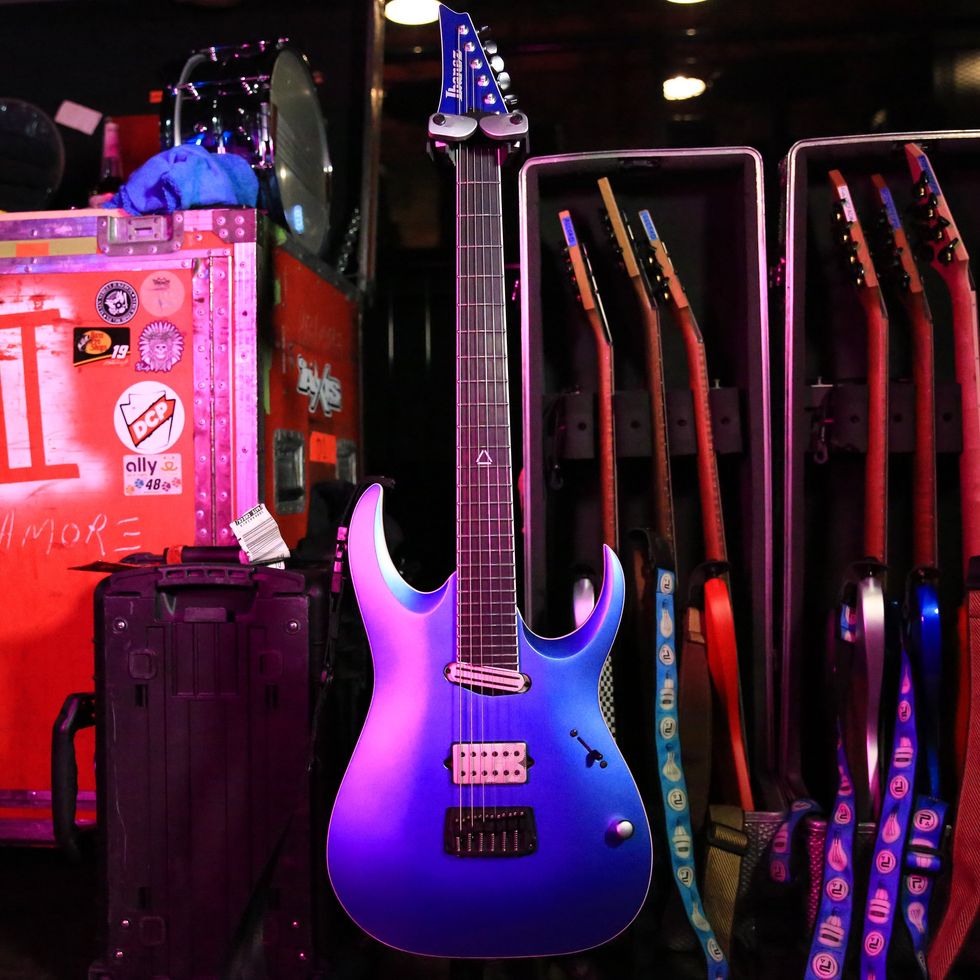
Jake Bowen busted out this blue belle first because it’s his most-recent signature—an Ibanez JBM9999 that features a basswood body in their RGA shape, a 5-piece maple-walnut neck, a bound-ebony fretboard, a 25.5" scale that crams in 27 frets, Gotoh MG-T locking tuners, and Ibanez’s Gibraltar Elite bridge, plus it comes loaded with a fresh set of Bowen’s latest signature DiMarzio Mirage humbuckers. The neck model is a custom-voiced, Strat-style, single-coil-sized humbucker that incorporates some finessed tones via the 5-way. Position one and five are standard and individually engage the bridge and neck humbuckers (respectively). Position four puts the neck humbucker into parallel mode. The center slot gets both humbuckers involved, while position two selects the bridge side of the neck humbucker and the neck side of the bridge humbucker. The reason Jake opted for the single-coil-sized humbucker was to inspire fans who want to swap in their favorite single-coil pickups without any extra routing.
Ibanez is known for their wild combinations of letters and numbers for product cataloging, but the 9999s have a significance to Bowen … beyond sounding like an injury law firm’s phone number. He’s a superfan of the Final Fantasy world and 9999 is the max damage you can get in the earlier games, so Bowen requested that gamer Easter egg and they obliged. All his 6-string signatures take Horizon Devices Progressive Tension Heavy 6 strings (.010–.014–.019–.030–.042–.058).
Back in Black
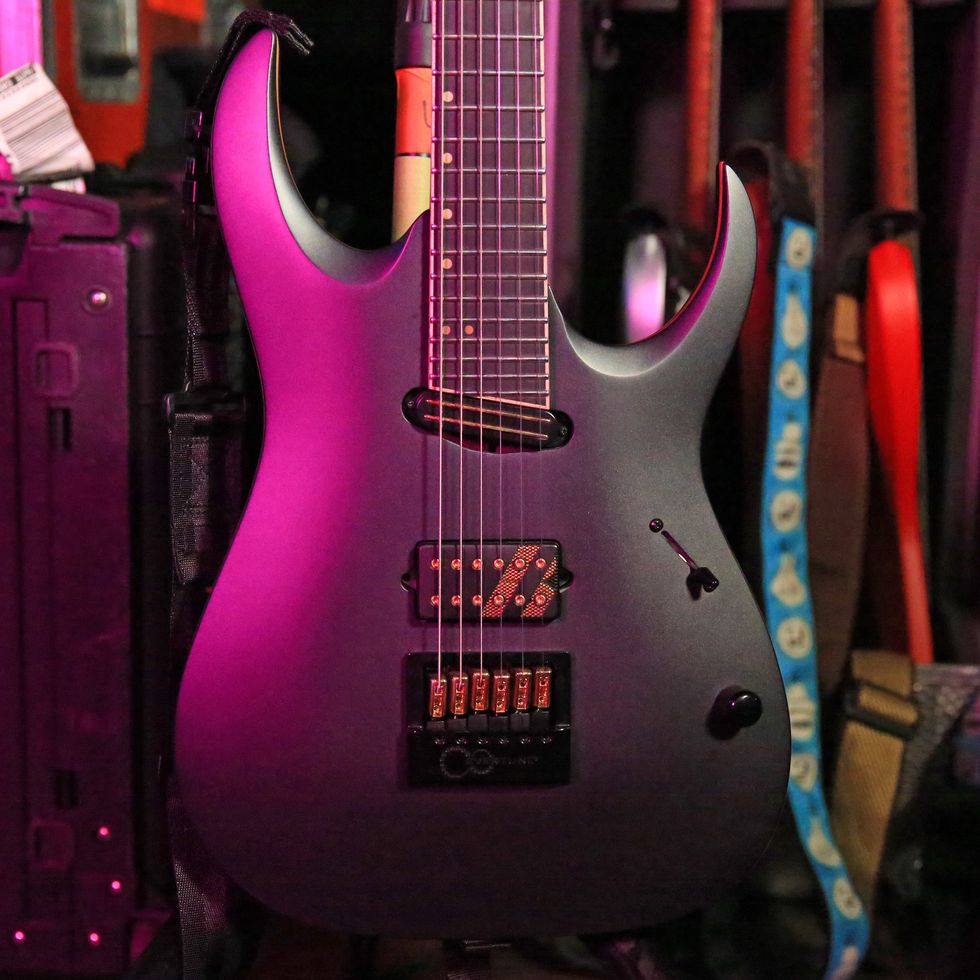
Bowen commissioned this sleek JBM9999 from Ibanez’s L.A. Custom Shop. It matches all the previous model’s accoutrements but shakes it up by including an Evertune bridge. That appointment means it comfortably rides in G–G–C–F–A–D tuning and sees the stage for “Reptile” and “Zagreus.”
The Mojo Machine
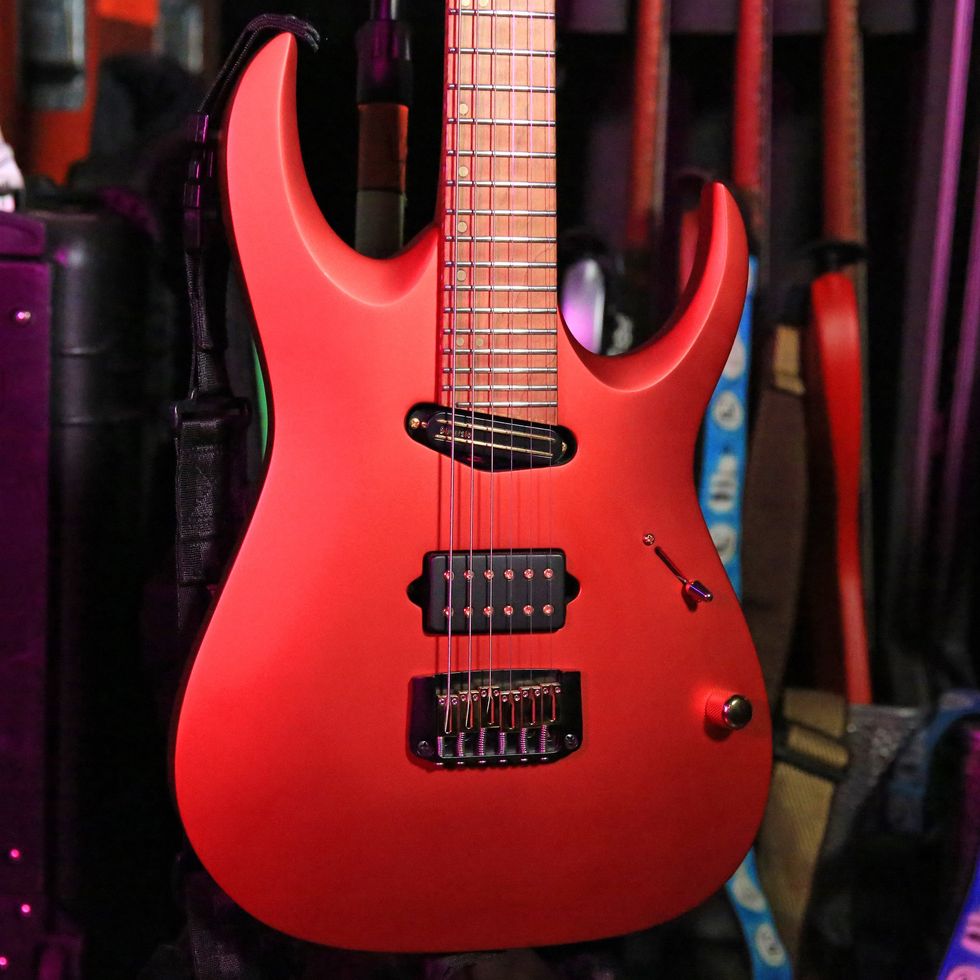
This JBM9999 has a few different wrinkles than the previous two. It has a roasted-maple neck and fretboard, and while the single-coil-sized neck humbucker looks like another Mirage model, it’s actually DiMarzio’s The Chopper. That pickup worked as a starting point when Bowen was testing out their rail hum-canceling Strat pickups, and that ultimately led him to the voicing of his signature Mirage version.
Knight in White Satin
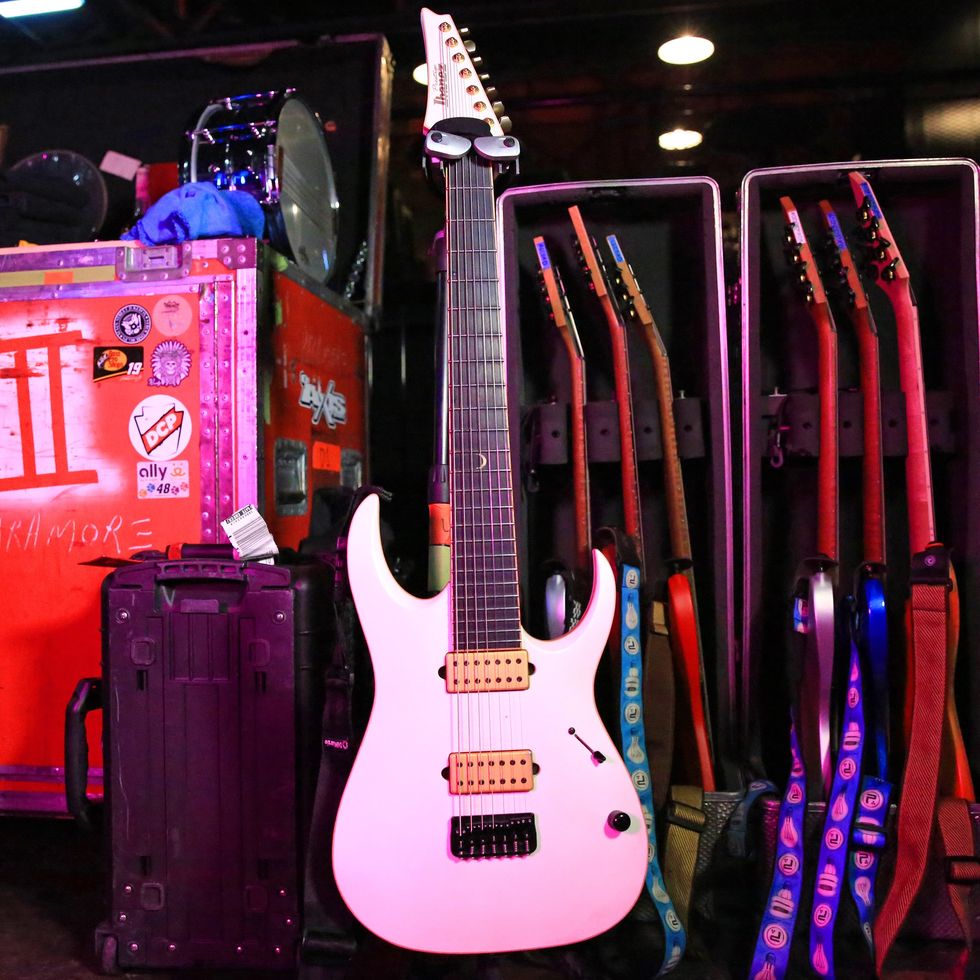
Lastly, here’s Jake’s signature Ibanez JBM100 7-string, stocked with his original signature DiMarzio Titan ’buckers, that was shown off in the 2017 Rundown. His first standard sig model was generally done in a matte black finish, but he wanted something special and felt the gold pickup covers would really pop with a white finish. The JBM100s have a mahogany body/maple top configuration.
A $200 Private Stock PRS?!
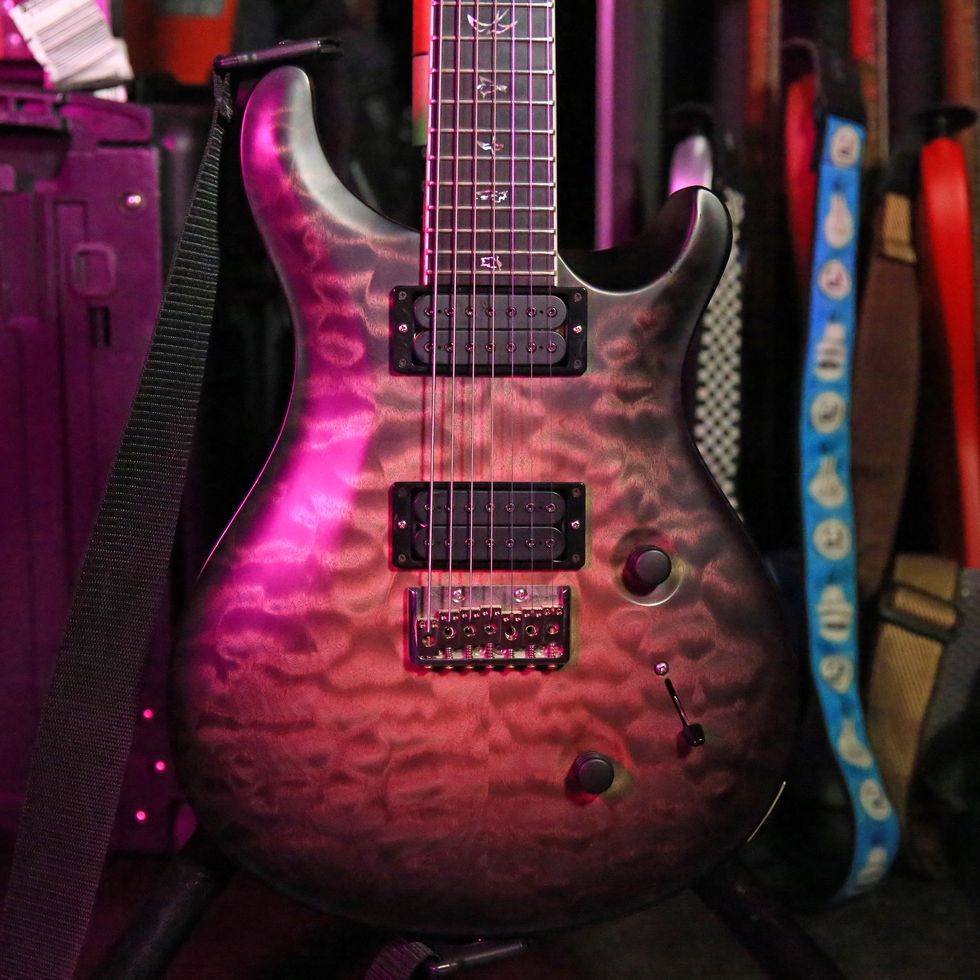
Back in 2016, Mark Holcomb ordered this 7-string custom from PRS’ Private Stock team. It’s based on his 2015 signature model, but with all of Paul Reed Smith’s bells and whistles. A few things make this guitar unique to PRS’ signature artist roster in that it has a 26.5" scale length, a flat 20" radius on the fretboard, and Holcomb’s first signature Seymour Duncan Alpha & Omega humbuckers.
When it was built, PRS sent the special instrument via FedEx (signature required), and it was left by the delivery person without Holcomb’s John Hancock outside his Austin, Texas home. It was swiped by a porch pirate and assumed to be gone forever. Mark rallied his online followers to get the word out and a fan recognized it in a flea market 60 miles south of Austin. The kicker: It was being sold for $200! The fan bought the guitar and returned it to Mark. The best part, Holcomb didn’t let the sloppy bandit deter him from touring with it as he uses it on “Ragnarok” and other low-tuned riffers. He laces all his 7-strings with Progressive Tension Heavy 7 (.010–.014–.018–.028–.039–.050–.065).
Holcomb Burst
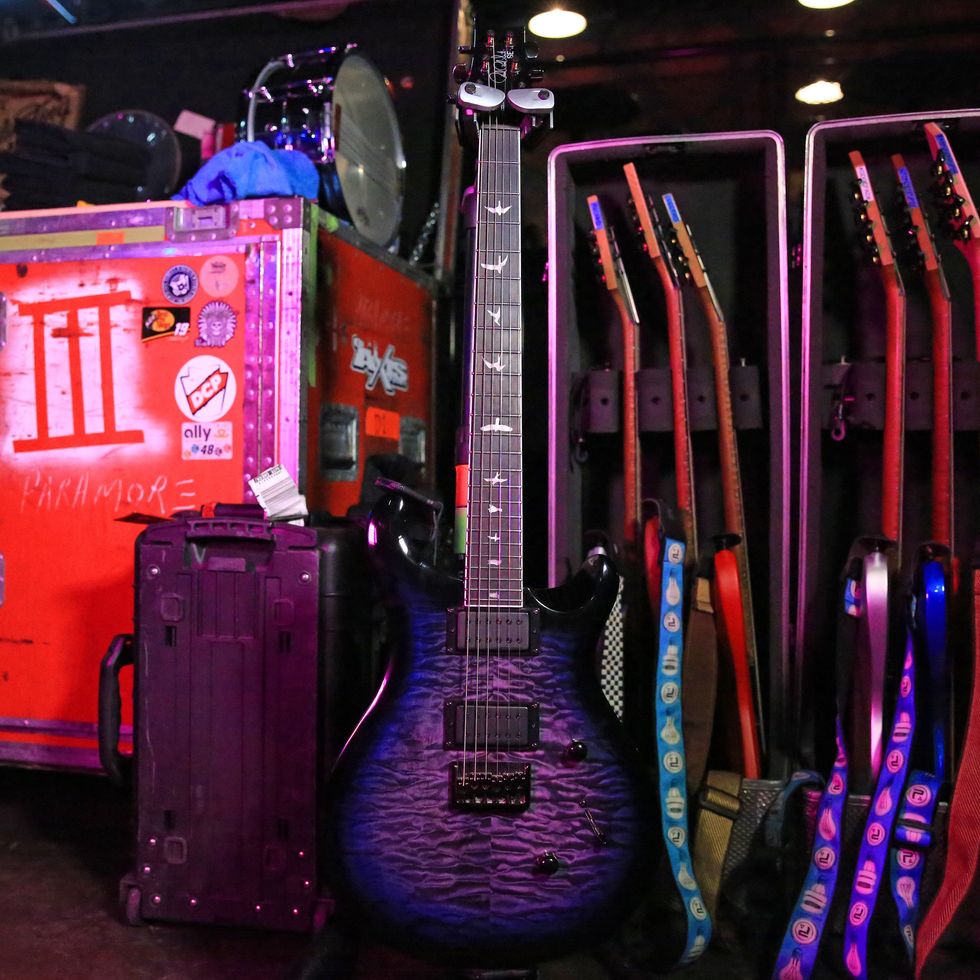
For any Periphery songs that only require a standard 6-string attack, he shoulders his brand-new 2023 PRS SE Mark Holcomb that is off-the-shelf stock. Ingredients include a mahogany body topped with a quilted maple top that incorporates an elegant violin carve, a satin maple neck with 24 frets, an ebony fretboard with a flat 20" radius, a 25.5" scale length, and this one leaves the factory with Holcomb’s just-released Seymour Duncan Scarlet & Scourge humbuckers. Controls are just a 3-way pickup selector, master volume, and push/pull tone knob for coil splitting. Holcomb puts Horizon Devices Progressive Tension Heavy 6 strings on all standard guitars.
7th Heaven
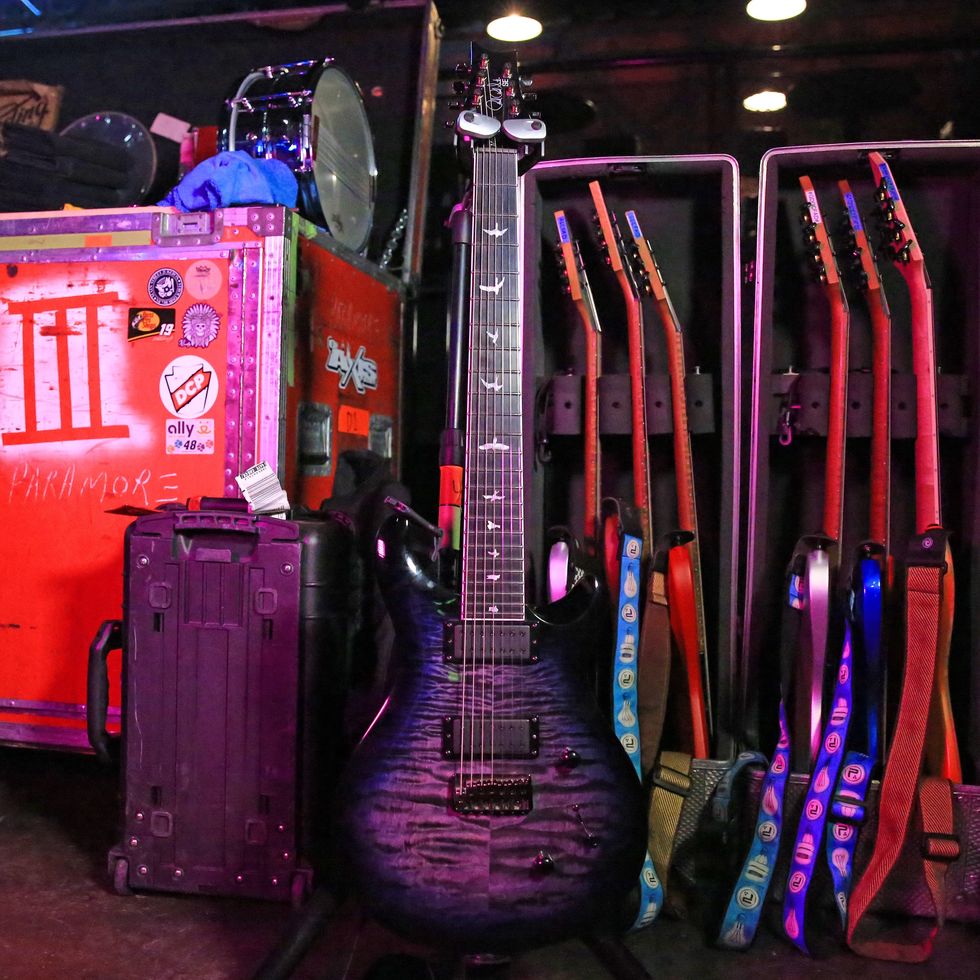
This is Holcomb’s PRS SE SVN signature that is identical to its little brother, but has the added string and a 26.5" scale.
Evertune Eviscerater
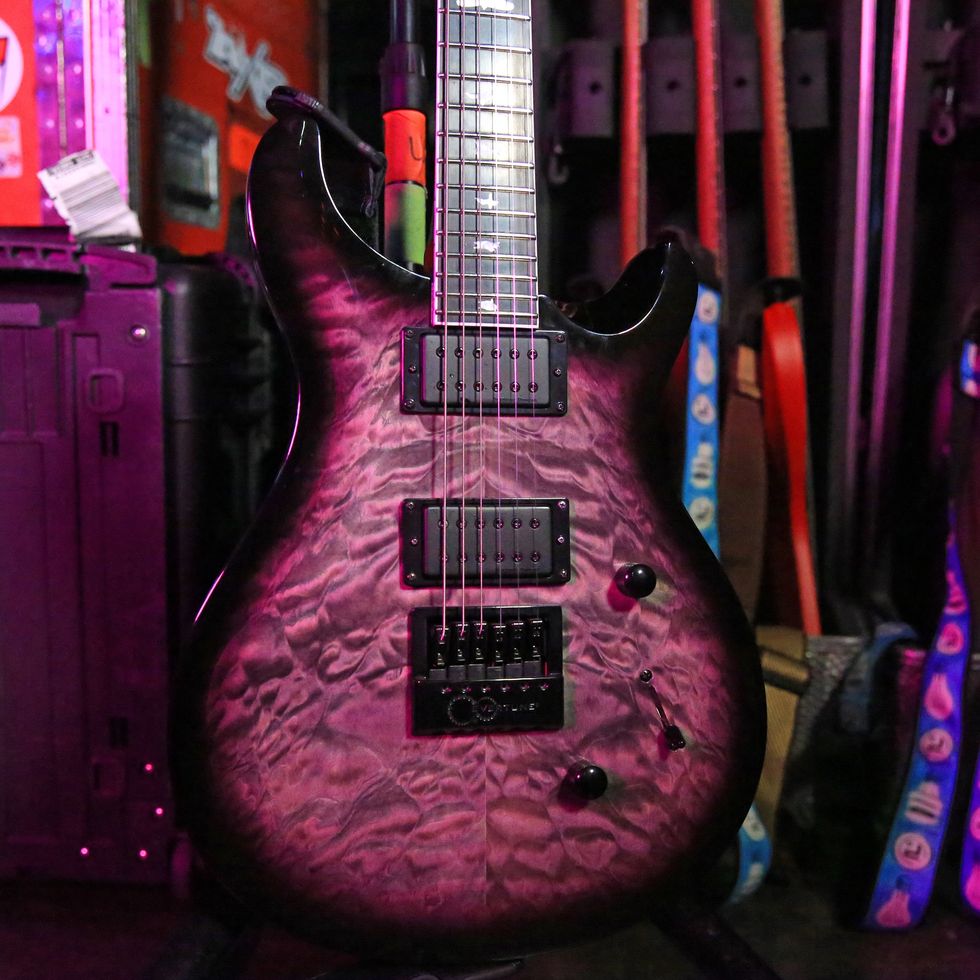
For the set opener “Reptile,” Holcomb enlists this PRS SE SVN signature that was modded with an Evertune bridge to accommodate “the stupid-low G tuning” that Mark stumbled upon while riffing away on vacation in Spain.
Reptilian Rocker
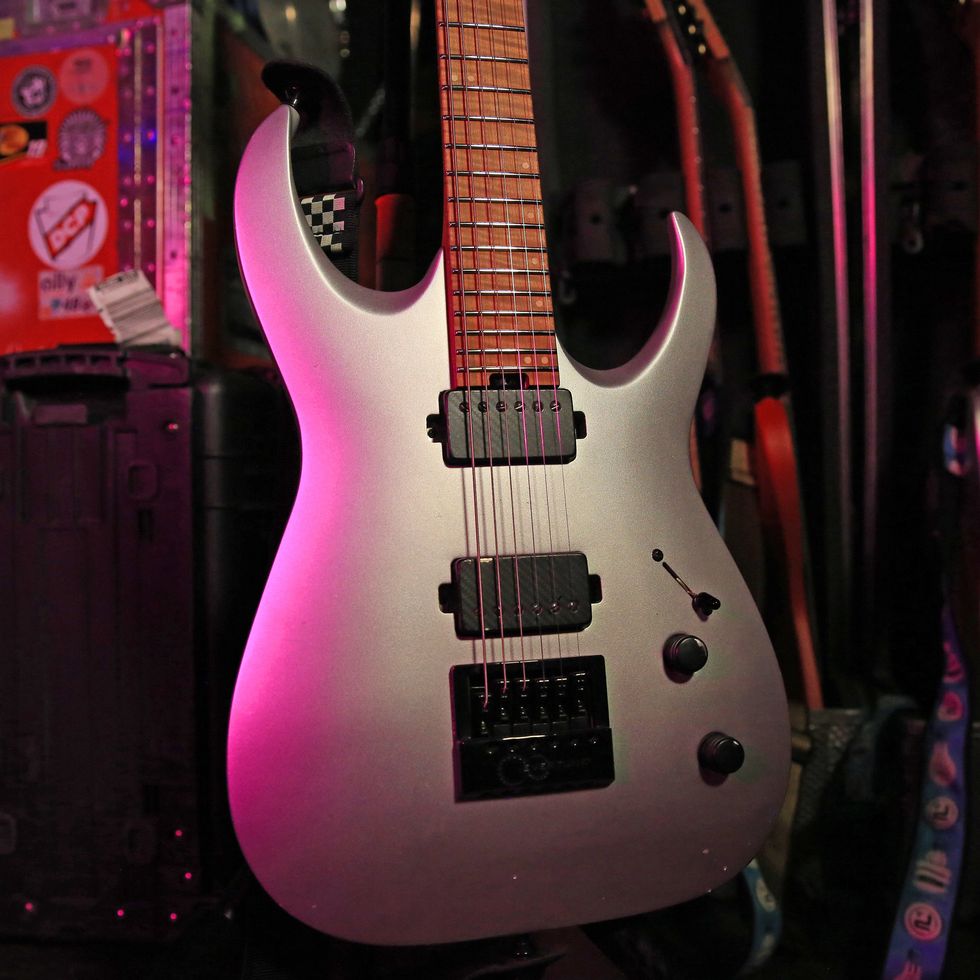
For the band’s rumbling G–G–C–F–A–D tuning, Misha Mansoor grabs this Jackson USA Misha Mansoor Signature Juggernaut HT6. Its DNA starts with a caramelized basswood body, caramelized quartersawn maple neck and fretboard, 24 jumbo stainless-steel frets, a Graph Tech TUSQ XL nut, a 25.5" scale, Hipshot open-gear locking tuners, and Misha’s signature Bare Knuckle Ragnarok humbuckers. He puts Horizon Devices Progressive Tension Heavy 6 strings on it. And it has a retro-fitted Evertune to keep things tight, prompting Mansoor to commented that “this tour is the most in-tune ‘Reptile’ has ever sounded. It’s been wonderful.” He notes that he recorded nearly all his parts for Periphery’s last two albums with this silver siren.
Orange You Glad
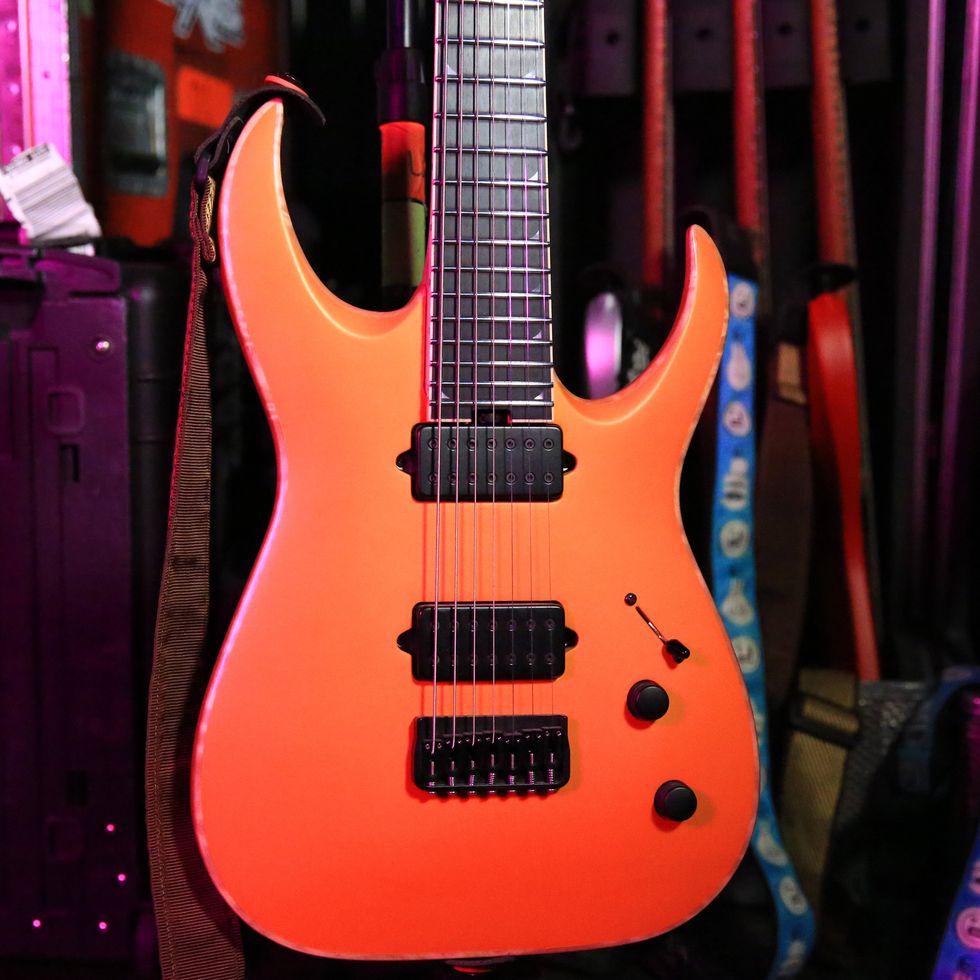
A few years back, Mansoor listed a bunch of gear on Reverb during an equipment purge. He almost listed this one but had second thoughts and is very glad he didn’t. His tech Vinnie gave it some serious TLC and it’s back in the rotation. A cool tidbit about this first-generation Jackson USA Misha Mansoor Signature Juggernaut HT7 is that it has a stunning quilted maple cap sitting over a roasted basswood body. There was a slight blemish on its top, so to salvage the build Misha suggested painting over the quilt, but leaving the edges exposed for a quilted binding effect. It sees work for “Ragnarok,” in their unique variation of drop-A-flat tuning (F#–D#–G#–C#–F#–A#–D#).
Snobs Need Not Apply
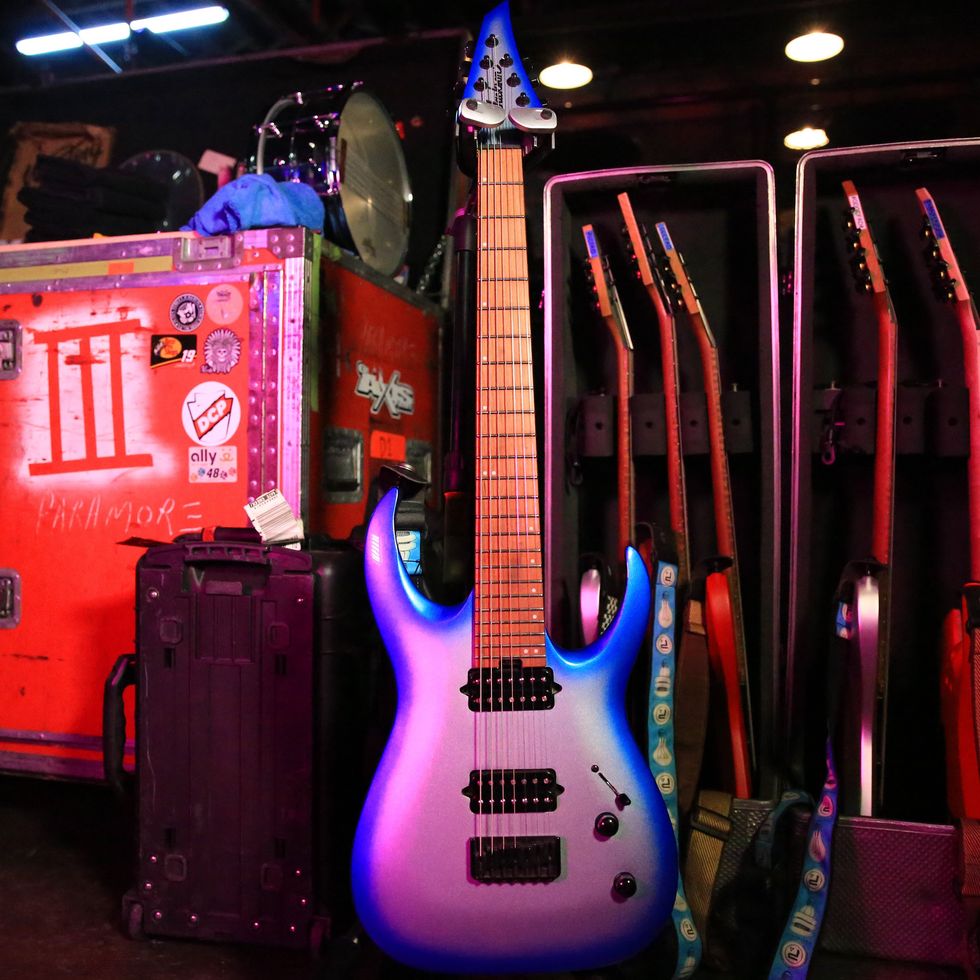
Another staple for Mansoor during Periphery’s live set is this import Jackson Pro Series Signature Misha Mansoor Juggernaut HT7 in shimmery blue sky burst. Many of the same appointments are here: a basswood body and a caramelized maple neck and fretboard. The stock models roar with a set of Jackson MM1 humbuckers, but Mansoor opted to upgrade with a set of Bare Knuckle Ragnaroks.
Easy Peasy
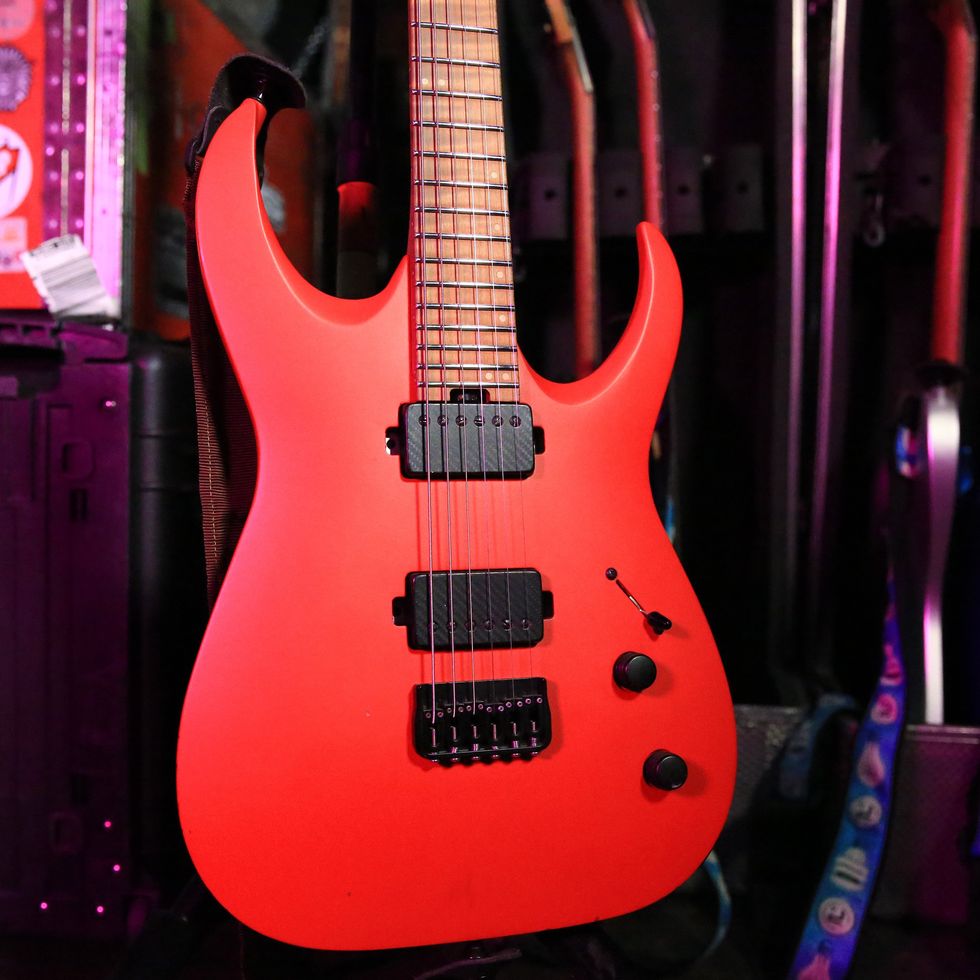
“This thing just shreds, man. It’s just so easy to play and it doesn’t fight me for the little note-y bits in ‘Marigold.’” The set closer puts this matte Jackson USA Misha Mansoor Signature Juggernaut HT6 into drop-C tuning. Mansoor is a mega car enthusiast and Formula 1 fan, so he had Jackson put this one in matte red to match Ferrari finishes.
Pass the Scalpel, Please
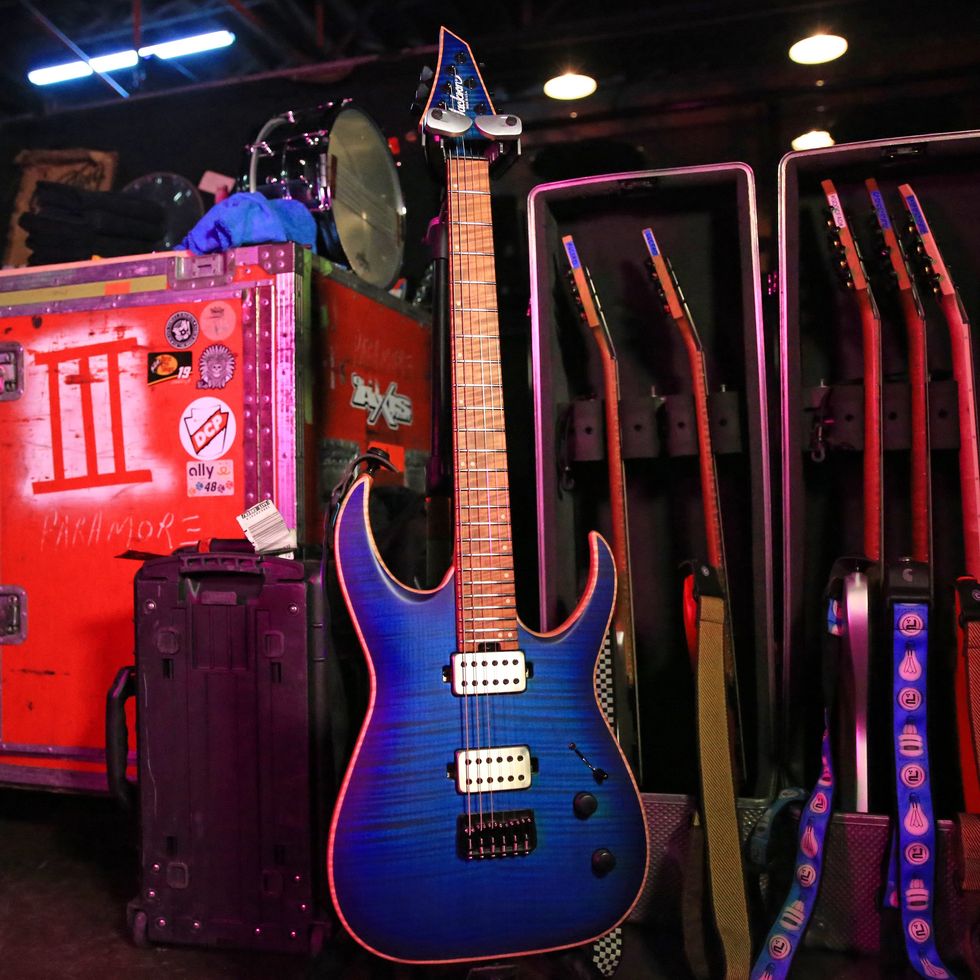
This might look yet another Jackson USA Misha Mansoor Signature Juggernaut HT6 with a basswood core and quilted maple top, but it has a mahogany body and flame maple cap for a darker sound and heftier weight. Misha’s signature Bare Knuckle Juggernauts give this baby a bite. Mansoor says the Ragnaroks are a sledgehammer, whereas the Juggernauts are a precision tool.
All in the Family
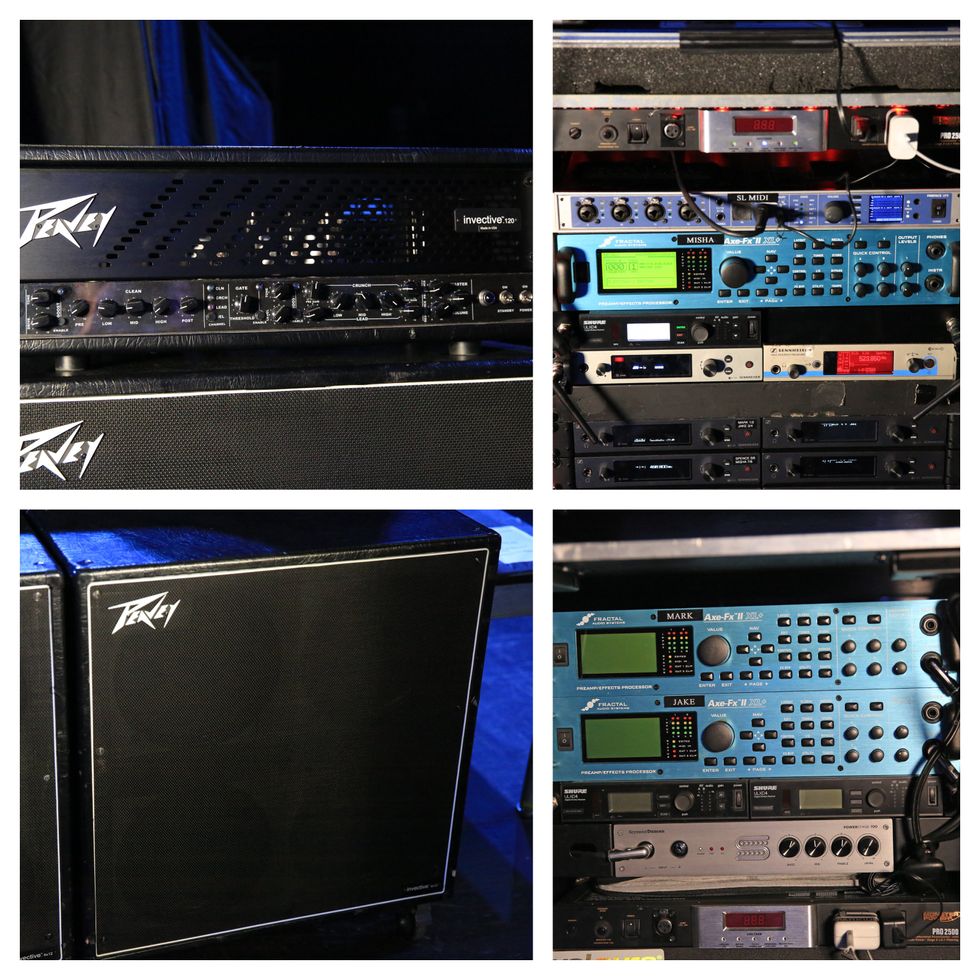
Misha and Jake have nearly identical setups and patches when it comes to amps and effects. Both are using Peavey Invective120 heads—a design alliance with Mansoor—that each run their own Fractal Audio Axe-Fx II XL+ units through a Peavey Invective 412 and out to FOH. The cabinets are loaded with two pairs of Celestion speakers: Vintage 30s and Creambacks. Mark uses a Fractal Audio Axe-Fx II XL+, but his is juiced by a Seymour Duncan PowerStage 700. He also has a Peavey Invective 412 cabinet onstage. In addition to live stage audio via 4x12s, each guitarist relies on Sennheiser EW IEM G4 Wireless In-Ear Monitor and side fills for a complete sound. And the three amigos plug their shred sticks into Shure ULXD4Q Wireless Units.
![Rig Rundown: Periphery [2023]](https://www.premierguitar.com/media-library/rig-rundown-periphery-s-jake-bowen-mark-holcomb-misha-mansoor-2023.jpg?id=33635214&width=1200&height=675)


![Rig Rundown: AFI [2025]](https://www.premierguitar.com/media-library/youtube.jpg?id=62064741&width=1245&height=700&quality=70&coordinates=0%2C0%2C0%2C0)


![Devon Eisenbarger [Katy Perry] Rig Rundown](https://www.premierguitar.com/media-library/youtube.jpg?id=61774583&width=1245&height=700&quality=70&coordinates=0%2C0%2C0%2C0)























































